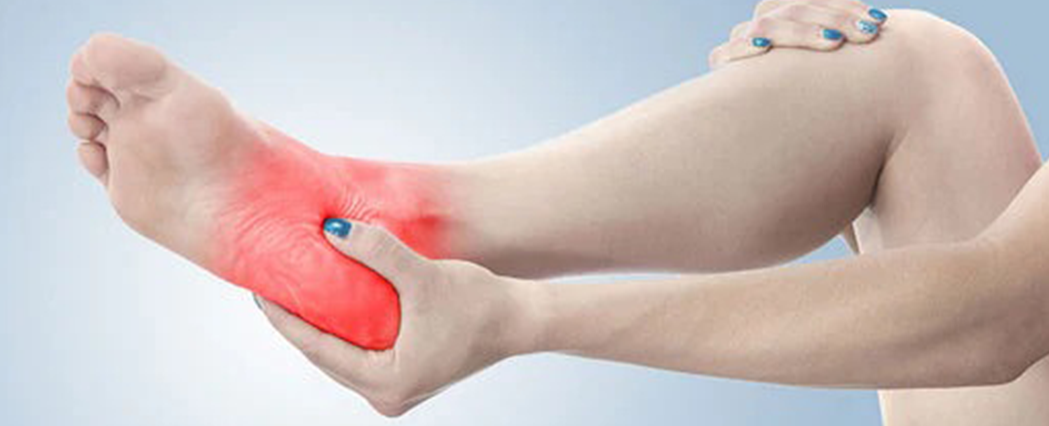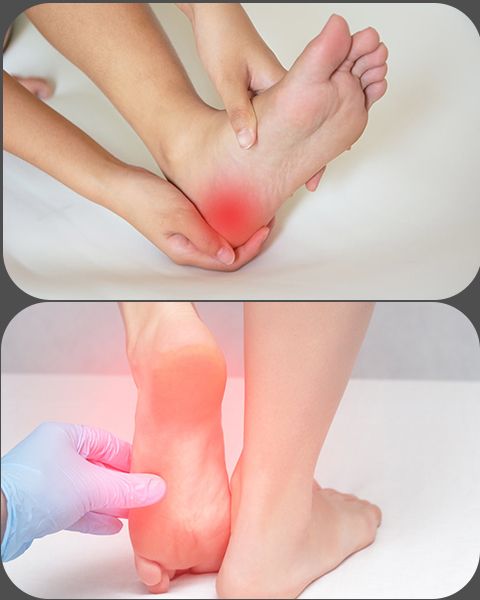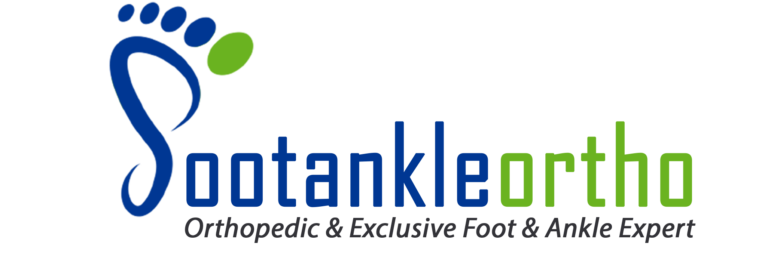HEEL PAIN
What is a Heel Pain?
Heel pain is one of the most common foot complaints and can affect people of all ages. It is usually felt under the heel (plantar heel pain) or just behind it (Achilles tendon pain). While heel pain is often mild at first, it can worsen over time and begin to interfere with daily activities like walking, exercising, or even standing. Heel pain may develop suddenly due to injury or gradually due to overuse or stress on the heel bone and surrounding tissues.

Common Heel Pain Symptoms
Depending on the underlying cause, heel pain may feel like:
A sharp or stabbing pain when taking the first steps in the morning
Aching or burning sensation in the heel throughout the day
Pain that worsens after long periods of standing or walking
Tenderness or swelling around the heel
Stiffness in the foot or ankle, especially after rest
Redness or warmth in the heel area
Bruising or discoloration around the heel
Pulling sensation along the arch or heel
Difficulty bearing weight on the affected foot
Limping due to pain
Numbness or tingling if a nerve is affected
Visible bony growth like a heel spur (in chronic cases)
What Causes Heel Pain?
There are several possible causes of heel pain, the most common being:
Plantar Fasciitis: Inflammation of the plantar fascia ligament that runs along the bottom of the foot. Most common cause of heel pain.
Achilles Tendinitis: Inflammation of the tendon connecting the calf muscles to the heel bone.
Heel Spurs: Bony growths on the underside of the heel bone, often associated with plantar fasciitis.
Bursitis: Inflammation of the fluid-filled sacs (bursae) near the heel joint.
Stress Fractures: Tiny cracks in the heel bone caused by repetitive force or overuse.
Sever’s Disease (in children): A common cause of heel pain in growing children, especially those active in sports.
Arthritis: Inflammatory conditions like rheumatoid arthritis or ankylosing spondylitis may affect the heel.
Obesity or poor footwear: Excess body weight and unsupportive shoes can increase stress on the heel.
Heel Pain Diagnosis
When you visit a doctor for heel pain treatment, the process typically begins with a thorough clinical examination of your foot. The doctor will ask questions about the type of pain you’re experiencing, when it occurs, and its specific location. This information helps guide the diagnostic process, which may include a physical examination to assess pressure points and tenderness, as well as a gait analysis to evaluate your walking pattern and foot structure. Imaging tests such as X-rays may be used to rule out conditions like heel spurs or fractures. In some cases, an ultrasound or MRI may be recommended to detect soft tissue inflammation or tendon injuries. An accurate diagnosis is crucial, as it forms the foundation for effective and long-lasting relief from heel pain.
Heel Pain Treatment
Most heel pain cases improve with conservative treatment. Your treatment plan will depend on the underlying cause, severity of pain, and daily activity levels.
Non-Surgical Treatment Options:
Rest and activity modification to reduce strain
Cold therapy or ice packs for inflammation
Supportive footwear with proper arch and heel cushioning
Orthotic inserts or heel cups
Stretching and strengthening exercises for plantar fascia and calf muscles
Anti-inflammatory medications (NSAIDs)
Physical therapy to improve mobility and relieve tightness
Night splints to stretch the plantar fascia overnight
Heel Pain in Children
In children, heel pain is commonly due to Sever’s disease, especially in those aged 8–14 who are physically active. The pain often worsens with sports and improves with rest.
Treatment includes:
Rest and icing
Heel cushions or shoe inserts
Calf muscle stretching
Avoiding high-impact activities temporarily
Proper supportive footwear
Early evaluation ensures timely relief and avoids complications.
When to See a Heel Pain Treatment Doctor
Consult a heel pain treatment doctor if you experience:
Persistent or worsening pain despite rest
Difficulty walking or putting weight on the heel
Swelling, redness, or warmth in the heel area
Numbness or tingling sensations
Pain in both heels or spreading up the leg
Surgical Treatment (If Needed)
Surgery is rarely needed but may be considered for severe or persistent cases. Surgical options include:
Plantar fascia release
Heel spur removal
Repair of torn tendons or ligaments
Dr. Shakti Swaroop will discuss surgical intervention only if all non-invasive treatments have failed.

Get Expert Heel Pain Treatment
Whether you’re struggling with daily discomfort or sharp pain when walking, Dr. Shakti Swaroop and his team provide comprehensive heel pain evaluation and personalized treatment plans.
📞 Book your consultation today for expert care and long-term relief from heel pain in Bhubaneswar.
frequently
asked questions
The most common cause of heel pain is plantar fasciitis, which results from inflammation of the plantar fascia ligament due to overuse, poor footwear, or tight calf muscles.
Mild heel pain may improve with rest, proper footwear, and home remedies. However, if the pain persists for more than a week or affects your daily routine, it’s best to consult a heel pain treatment doctor for a proper diagnosis.
Most heel pain is treated with non-surgical options such as ice therapy, stretching exercises, custom orthotics, physical therapy, and anti-inflammatory medications. Surgery is rarely needed.
Yes, heel pain is common in active children, especially due to Sever’s disease. It’s important to manage it early with rest, proper footwear, and stretching to avoid long-term issues.
If you’re looking for specialized heel pain treatment in Bhubaneswar, Dr. Shakti Swaroop offers advanced diagnosis, personalized care, and both conservative and surgical options tailored to your needs. Book an appointment today for expert care.
